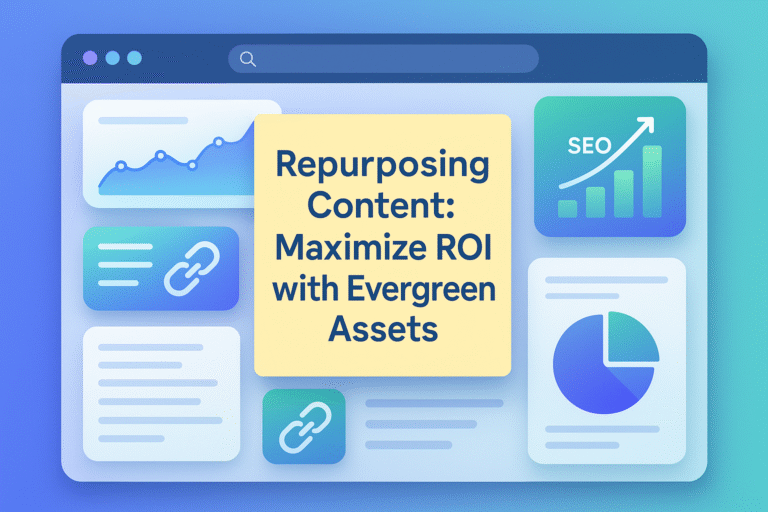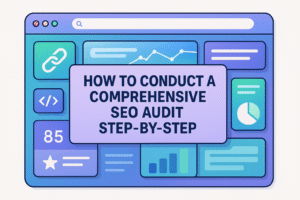In today’s fast-paced digital landscape, creating content that consistently captures audience interest while optimizing every dollar is paramount for brands. The key to success is mastering the art of repurposing content, ensuring valuable content remains evergreen and maximizing return on investment (ROI) with minimal ongoing effort. By revitalizing existing assets, businesses sustain relevance and extend the lifespan of their marketing initiatives.
Content repurposing transcends mere recycling; it is a strategic method to amplify brand visibility and engagement across platforms. This strategy focuses on identifying high-performing and evergreen content that can be adapted into various formats to resonate with diverse audience segments. Whether transforming blogs into visually compelling infographics or converting webinars into comprehensive eBooks, the avenues for keeping content fresh and impactful are limitless.
In this article, we will dissect the complexities of content repurposing, from selecting the right assets to utilizing AI tools for automation. We will explore strategies to boost engagement across multiple platforms, best practices to maintain consistency, and the SEO advantages inherent in repurposing. Join us as we demonstrate how content repurposing is not only a cost-effective strategy but an essential route to optimizing ROI and expanding audience reach.
Understanding Content Repurposing
Content repurposing is an effective strategy to amplify the reach and impact of your existing content by transforming it into different formats or distributing it across various platforms. This approach begins with an audit to evaluate existing pieces of content and identify opportunities for reformatting. For example, a single blog post can be converted into social media posts, hosted as podcast episodes, or turned into engaging video content like Instagram Reels.
Repurposing benefits include reaching wider audiences and enhancing online presence. By adapting content for the unique aspects of social media platforms and targeting diverse audiences, you expand your reach significantly. Additionally, repurposing content can boost SEO rankings, as it allows you to create multiple pieces around a single keyword, all linked back to the original source.
Integrating content repurposing into your marketing strategy optimizes resources, maximizing the value delivered over time. Consider the following practices for successful content repurposing:
- Transform articles into podcasts or videos.
- Extract key points to create email newsletters.
- Repackage white papers into short-form visuals.
To ensure effectiveness, keep content fresh and relevant while aligning with your overall content strategy.
The Importance of Repurposing for Brand Visibility
Repurposing content is a vital strategy for brands aiming to boost their visibility and engage with diverse target audiences. By transforming a single piece of content into various formats—such as turning blog content into podcast episodes or short-form videos for social media platforms—companies can effectively connect with different audience segments. This practice not only enhances brand visibility across social media channels but also extends the reach of marketing efforts, as it encourages interaction with wider audiences.
Furthermore, repurposing supports content marketing strategies by maintaining a steady flow of high-quality content. Regularly publishing repurposed pieces around a specific keyword can also improve search engine rankings, thereby increasing a brand’s online presence. This approach saves time and resources while ensuring the content remains fresh and relevant across multiple channels.
Consider these benefits of content repurposing:
– Engage with various target audiences
– Improve search engine rankings
– Extend content lifespan
– Expand online presence
By embracing this tactic, brands can ensure that their content remains engaging, impactful, and consistently visible, reinforcing their position within the industry.
Selecting High-Performing and Evergreen Content
Selecting high-performing and evergreen content is crucial for an effective content repurposing strategy. Evergreen content retains its relevance over time, offering flexibility and numerous customization options across social media platforms, blog content, and more. It is vital to focus predominantly on this type to engage wider audiences consistently.
To begin, utilize tools like Google Analytics to pinpoint your most popular pieces of content from the past year. High-performing content should align with your strategic goals and resonate well with target audiences, ensuring they appeal across various social media channels, email newsletters, and beyond.
Avoid repurposing content that becomes quickly outdated or was tailored for specific events or announcements, as its relevance diminishes rapidly. Instead, opt for content that naturally maintains interest across different content formats, such as video content, podcast episodes, or blog posts.
Top Practices for Selecting Content:
- Prioritize evergreen content for flexibility.
- Use analytics to identify popular pieces.
- Align content with strategic goals.
- Avoid time-sensitive or event-specific content.
By adhering to these best practices, your content marketing strategies can leverage evergreen, high-quality content formats effectively.
Effective Formats for Content Repurposing
Content repurposing is a versatile strategy that enables creators to adapt existing material into various formats, optimizing its reach and engagement across diverse platforms. By leveraging this practice, you can transform a single piece of content, such as a blog post, into numerous other formats like videos, infographics, or podcasts. This not only caters to different audience preferences but significantly extends the lifespan and value of the content. Effective content repurposing involves refreshing outdated materials, making them suitable for new target audiences while embracing diverse media platforms. Tools like Jasper facilitate this process by improving and converting existing content into different formats, promoting increased traffic and audience engagement.
Blogs to Infographics
Transforming a blog post into an infographic is a popular technique within content repurposing, effectively broadening its reach and impact. Infographics convert text-heavy material into a visually appealing format by summarizing key points and presenting them as graphics. This approach allows the audience to grasp complex information quickly and efficiently, enhancing engagement compared to traditional text formats. Incorporating AI tools in creating infographics can streamline the process, ensuring the content is optimized for various channels and audience segments. By reimagining blogs as infographics, content creators can leverage visual appeal to attract attention and convey significant information succinctly across multiple platforms.
Videos to Podcasts
Repurposing video content into podcasts is an efficient strategy for reaching auditory-focused audiences. This process involves extracting audio from video files, editing it with introductions and transitions, and saving it as an MP3 file for distribution. Many webinar software tools simplify this conversion by offering audio download features. Once a podcast is created, it can be uploaded to various platforms to expand its availability and tapping into the growing podcast trend. Combining this format with social media and website integration increases reach. Overall, video-to-podcast conversion allows existing content to gain fresh exposure in a new and trending format.
Articles to Social Media Posts
Adapting articles into social media posts optimizes existing content for increased visibility. This involves distilling key ideas, quotes, and statistics into shorter, engaging pieces suitable for platforms like Instagram or Twitter. Utilizing tools like Google Analytics, creators can identify evergreen content that’s ripe for repurposing into interactive social media formats, such as carousel posts or Twitter threads. Tailoring posts with distinct graphics or animations rather than repeating the same visuals enhances engagement. Additionally, AI tools can facilitate the repurposing process by creating content that aligns with a brand’s voice while catering to diverse audience preferences. This approach increases the article’s reach and appeal in a concise, accessible manner.
Webinars to eBooks
Repurposing webinars into eBooks transforms visual presentations into comprehensive written content, extending their lifespan and value. This involves transcribing audio or video content into a structured document, allowing for the creation of in-depth, educational material. eBooks based on webinars can serve as valuable resources for audiences, offering insights in a more detailed format. This conversion strategy not only boosts content visibility but also maintains relevance by making the educational material easily accessible. Capturing key insights from webinars and structuring them as eBook chapters offers readers targeted and informative content, reinforcing marketing strategies and cultivating lasting audience engagement.
Enhancing Engagement Across Multiple Platforms
In today’s digital landscape, connecting with wider audiences requires a sophisticated approach to content distribution. Repurposing content serves as a powerful content marketing strategy to enhance engagement across multiple social media platforms. By adapting a single piece of content into several formats, such as blog content, social media posts, podcast episodes, or video content, you enable it to reach different target audiences with varying preferences.
This not only breathes new life into existing materials but also ensures they remain relevant and engaging across different channels. For instance, transforming webinars into concise blog posts, or taking social media metrics like likes and shares to repurpose high-engagement content, can effectively broaden your reach. Evaluating the effectiveness through these metrics provides opportunities to refresh outdated content, infuse it with high-quality content updates, and maintain its relevance. Armed with a strategic content repurposing strategy, you can optimize engagement and maintain an ever-growing online presence.
Strategies for Instagram
Instagram remains a dynamic platform that thrives on visual and engaging content. Repurposing involves transforming high-performing content into formats like Instagram carousel posts, which can retain the essence of the original piece while adapting to the platform’s visually driven nature. Start by auditing existing content to identify potential pieces suitable for Instagram repurposing. For example, old blog posts with strong engagement can inspire carousel images or Instagram Reels, offering a fresh format that speaks to Instagram’s audience.
Customizing video content using third-party tools before uploading helps remove platform-specific watermarks and enhances the aesthetic appeal. Testing multiple content formats, such as listicle-style videos from repurposed video content, allows you to experiment and refine strategies based on audience response. By tailoring your repurposed content to Instagram, you maximize engagement and keep your content strategy dynamic and responsive.
Leveraging LinkedIn Audiences
LinkedIn is a unique platform that benefits significantly from educational and industry-focused content. Repurposing content on LinkedIn should prioritize bite-sized lessons that engage professional viewers, whether through carousel presentations or succinct videos. Memes and lighter content can be shared, but chunking content into educational pieces often results in higher engagement levels. Consider using LinkedIn Articles to breathe new life into existing blog posts, thereby extending both reach and engagement.
Building a LinkedIn community requires thoughtful repurposing of content to align with the professional interests of your audience, ensuring that each piece complements your platform goals and nurtures meaningful interactions. Delivering high-quality, relevant content that speaks to LinkedIn’s unique audience can significantly boost your online presence and establish you as a thought leader in your field.
Creating YouTube Content
YouTube, a powerhouse for long-form video content, offers numerous opportunities for content repurposing. Transforming YouTube videos into shorter clips suitable for platforms like Instagram Reels, TikTok, and Shorts is an effective way to capture the attention of audiences interested in short-form video. This method enables you to optimize content for key social media channels, increasing platform-specific performance.
Furthermore, embedding these videos into blog posts can enhance SEO and extend audience reach, melding video with text for broader discoverability. For live content, incorporating YouTube into a restreaming strategy expands virtual event attendance by simultaneously broadcasting across various channels, thus maximizing visibility. By thoughtfully transforming and redistributing YouTube content, you maintain engagement across platforms while tapping into audience segments that prefer different content types.
Utilizing AI Tools for Content Automation
In today’s rapidly evolving digital landscape, AI tools are transforming how content is created and managed, offering exciting opportunities for content repurposing. These intelligent platforms allow content creators to automate the generation and transformation of content, saving time and expanding reach. Tools like Descript and RightBlogger are perfect examples, utilizing AI to convert video to text and optimize SEO respectively, thereby ensuring that each piece of content speaks to a wider audience. By adapting content to various forms such as video, audio, and written formats, brands can maintain consistent messaging across all social media platforms and enhance their online presence.
ChatGPT for Text Generation
ChatGPT stands out as an advanced AI tool that excels in understanding and generating human-like text, making it a valuable asset in content marketing strategies. This versatile tool is not just for creating fresh content; it’s also adept at repurposing existing materials by summarizing or translating them. By injecting new life into old information, ChatGPT assists marketers in reaching wider audiences and maintains relevance by providing content tailored to specific target audiences. Its ability to streamline the content production process makes ChatGPT essential for any brand looking to prolong the life and impact of their communications across social media channels.
Jasper for Content Restructuring
Jasper is another powerful platform designed to aid content creators in maximizing the utility of their content through effective restructuring. Offering over 52 templates, Jasper allows users to seamlessly transform content into different formats, whether adapting social media posts into blog content or converting podcast episodes into short-form video scripts. Its Content Improver Template is particularly beneficial for incorporating relevant keywords into existing phrases, aligning with SEO best practices. With Jasper, content creators can efficiently execute a content strategy that emphasizes repurposing, ensuring that each piece of content meets the needs of diverse audiences across various platforms while maintaining high-quality standards.
Best Practices for Consistency and Cohesion
Repurposing content effectively requires maintaining consistency and cohesion across all formats and platforms. Start by conducting a thorough audit of your existing content to identify pieces with potential for transformation. This ensures that the core message aligns with various content types and target audiences.
Adopt a content repurposing strategy that includes converting a blog post into Visual Content such as Instagram Reels or short-form video. This not only boosts engagement but also expands reach on social media platforms. Ensure that high-quality content is adapted seamlessly, maintaining tone and style across different social media channels and content formats.
Consider the following best practices:
– Maintain a Unified Brand Voice: Keep your messaging consistent across all pieces of content to reinforce your brand identity.
– Adapt for Platforms: Tailor your content for specific platforms while preserving the original intent.
– Leverage Existing Assets: Use previous content like white papers or podcast episodes to create relevant content for diverse mediums.
– Track Performance: Monitor how repurposed content performs on different channels to tweak strategies effectively.
Repurposing enriches your content marketing strategies by reaching wider audiences and enhancing SEO. It breathes new life into evergreen content and strengthens your online presence.
SEO Benefits of Content Repurposing
Repurposing content is a smart strategy to enhance your SEO efforts. By creating multiple pieces of content around a single keyword, you can significantly improve your visibility on search engines. This method allows for the publication of different content types—such as blog posts, social media posts, or podcast episodes—linked to your website, boosting your ranking for various keywords.
A key SEO benefit of content repurposing is the ability to target similar keywords across diverse formats. This approach makes your content more search engine-friendly, attracting a wider audience. For example, using a tool like a YouTube Video to Blog Post Generator can transform video content into well-optimized blog posts, bringing in additional readers from search engines.
Repurposed content also extends the life of your original material across various platforms. This ongoing presence provides compounded SEO benefits through continuous publishing, keeping your content fresh and relevant. By leveraging content repurposing strategies, you ensure your online presence remains strong and your content reaches its full potential.
By developing a solid content repurposing strategy, you can maximize the reach and efficacy of your high-quality content. This strategy is invaluable for sustaining and enhancing your search engine rankings.
Steps to Reduce Content Production Costs
Repurposing content can significantly reduce content production costs while maximizing your marketing efforts. Here are some key steps to help you achieve this:
- Audit Existing Content: Start by reviewing your current content assets, such as webinars, YouTube videos, and blog posts, to identify materials that can be transformed into other formats.
- Utilize AI Tools: Leverage AI tools to adapt and convert content into different formats like infographics, blog articles, and email newsletters, reducing both labor and time.
- Transform Content Formats: For instance, convert a YouTube video into a blog post or an infographic. Such transformations are cost-effective and ensure that high-quality content reaches wider audiences.
- Implement a Content Repurposing Strategy: Develop a strategy to systematically repurpose content across various social media platforms like Instagram Reels and LinkedIn, utilizing different content types to maintain a robust online presence.
- Monitor and Adjust: Track the performance of repurposed content on different channels to refine your strategy and focus on content types that work best for your target audiences.
By incorporating these practices into your content marketing strategies, you can stretch budgets further without compromising on reach or quality.
Expanding Audience Reach through Tailored Content
Expanding your audience reach through tailored content is a strategic approach that leverages content repurposing. By converting existing materials such as virtual event sessions into new formats like blog posts, social media content, or email newsletters, marketing teams can engage target audiences across diverse platforms.
Repurposing content for social media posts, like turning engaging statistics into tweetable elements, enhances reach on platforms such as Twitter. Additionally, linking these pieces of content back to the original website can improve search engine rankings, indirectly enlarging audience reach.
Utilizing varied content formats allows you to connect with audiences of differing preferences. For example, short-form video content like Instagram Reels or converting podcast episodes into blog content can attract and engage different segments.
| Original Content | Repurposed Formats |
| Blog Post | Social Media Posts, White Papers |
| Podcast Episode | Blog Content, Video Highlights |
| Webinar | Visual Content, Shareable Infographics |
The key is to adapt high-quality content into formats that captivate and engage, ensuring it remains relevant and evergreen. This practice not only boosts engagement but effectively extends reach by delivering fresh content to existing and potential audiences.
Crafting Compelling Narratives
Crafting compelling narratives through content repurposing can significantly enhance your online presence by reaching wider audiences. A key element of a content repurposing strategy is assessing existing pieces of content. Identify which can be reshaped into new formats or distributed across different platforms. For instance, transforming a blog post into engaging social media posts or Instagram Reels taps into diverse content types and maximizes the reach of your message.
Effective repurposing goes beyond merely cross-posting; it involves tailoring and reimagining content to align with the unique features and audience preferences of each social media channel. Consider the platform’s demographics and functionality—short-form video for platforms like TikTok or visual content for Instagram.
To prioritize which content to repurpose, align with strategic objectives: rejuvenate traffic to evergreen blog content or expand your brand’s reach with fresh content. Repurpose by converting text into video content, attracting audiences who prefer different media.
Here’s a simple approach:
| Content Type | Repurposing Format |
| Blog Post | Social Media Snippet |
| Podcast Episode | Video Content Clip |
| White Paper | Email Newsletter Series |
These practices for content repurposing ensure that high-quality content continues to generate value, fitting neatly into broader content marketing strategies.
Incorporating Powerful Visuals
Incorporating powerful visuals when repurposing content can significantly amplify your content marketing strategy. By transforming existing text-based materials into engaging visual content, you tap into a broader array of audience preferences. This approach enhances your online presence and boosts the overall impact of your piece of content.
Visual content can be derived from long-form materials, such as blog posts, podcast episodes, or white papers, by highlighting the most compelling elements. This not only makes your content easier to digest but also more shareable across social media platforms.
Utilizing AI tools can simplify the transformation process, making it quicker and more efficient. These tools aid in converting text into visually appealing formats like Instagram Reels, short-form videos, or graphics, ensuring high-quality content that captivates target audiences.
It’s also essential to optimize visual content for specific social media channels. Each platform has its unique attributes, and aligning visuals with these can significantly enhance audience engagement.
Here’s a quick list to follow:
– Identify key elements from your content.
– Use AI tools to create visuals.
– Customize visuals for each platform’s uniqueness.
By following these practices for content repurposing, you ensure your content continues to captivate and engage wider audiences effectively.
Optimizing Content for Diverse Channels
Optimizing content for diverse channels involves strategically transforming high-performing pieces into various formats to extend their reach across social media platforms. This process starts with evergreen and high-quality content, such as blog posts, videos, and podcast episodes, ensuring they are updated with fresh, relevant information.
Utilizing AI tools can streamline repurposing practices. These tools automate transcription, format conversion, and platform optimization, tailoring content to the preferences of each target audience. However, a balance of AI and human oversight is crucial to maintain originality and emotional impact.
Effective content repurposing benefits from using Content Management Systems (CMS) and Digital Asset Management (DAM) systems. These technologies efficiently manage content assets, adapting them into blog content, Instagram Reels, or email newsletters, reaching wider audiences with tailored social media content.
Here’s a quick look at how content can be repurposed:
| Original Content Type | Repurposed Formats |
| Blog Post | Social media posts, email content, infographics |
| Podcast Episode | Video snippets, quotes for social media, articles |
| Video Content | Short-form videos, GIFs, blog summaries |
By selecting the right content types and employing a robust content repurposing strategy, brands can enhance their online presence and connect with diverse audiences.
Common Challenges and How to Overcome Them
Repurposing content is an effective strategy in content marketing, but it comes with challenges. A common mistake is trying to repurpose content into multiple formats for all social media platforms. This can dilute the content’s effectiveness and strain resources. Focus your efforts on platforms where you’re already building a community or wish to establish one.
Reaching new target audiences also presents a challenge. To engage wider audiences, adapt content into formats that cater to how various groups consume content. This might include transforming a blog post into short-form video content like Instagram Reels or creating podcast episodes from webinars.
Maintaining high-quality content in new formats requires more than just re-publishing. Careful adaptation is necessary to preserve context and relevancy. Regularly update content to align with customer search intent and channel-specific needs.
Here’s a quick checklist for effective content repurposing:
– Identify active or target social media channels.
– Tailor content formats to engage specific audiences.
– Preserve quality and context in new content formats.
– Regularly update content to ensure it remains relevant.
By focusing on these strategies, you can enhance your online presence without spreading your resources too thin.
Conclusion: Why Repurposing is Essential for ROI Maximization
Repurposing content is a powerful strategy for maximizing return on investment (ROI). By adapting existing content to suit various social media platforms and formats, businesses can reach wider audiences, enhancing their online presence. This practice not only extends the lifespan of high-quality content but also improves engagement by making it more accessible to target audiences.
Strategically repurposing content around a specific keyword can boost SEO rankings, increasing visibility on search engines. This approach ensures that your content marketing strategies are both efficient and effective.
Adapting content into innovative formats like short-form videos, Instagram Reels, or podcast episodes can capture the attention of different social media channels and platforms. Moreover, transforming blog posts into email newsletters or white papers into Visual Content offers fresh ways to convey relevant content.
Here’s a quick breakdown of content formats:
| Content Type | Repurposed Format |
| Blog Posts | Social Media Posts |
| Video Content | Instagram Reels |
| Podcast Episodes | Blog Content |
| White Papers | Email Newsletters |
In conclusion, repurposing content is an essential practice for maximizing ROI and optimizing content marketing strategies. Embracing content repurposing ensures your fresh content gains the attention it deserves across diverse platforms and audiences.
FAQs
Repurposing content is an effective strategy to maximize the potential of your existing materials by transforming them into diverse formats suitable for different platforms. This approach enhances the content’s life cycle, expanding its reach not only to new audiences but also across various channels. Unlike simply sharing content, repurposing requires thoughtfully adapting the material to fit distinctive platform needs and audience preferences. This practice not only enhances the content’s accessibility but also its appeal to broader audiences. By effectively repurposing, businesses can utilize their marketing resources efficiently, reducing the constant need to create new content.
How often should content be repurposed?
Determining the frequency of content repurposing involves understanding both the platforms you’re targeting and the audience you wish to engage. The key is to select content and channels that are aligned with your activity or community-building goals. Regularly updating and transforming content, such as converting text posts into videos, can rejuvenate interest and expand your reach with minimal effort. Known as content recycling, this practice focuses on extending the reach of your materials by reusing them across different formats. Strategically repurposing content at suitable intervals ensures ongoing engagement and maximizes existing content value.
What are the pitfalls of repurposing content?
While repurposing content offers several advantages, there are pitfalls to avoid. One significant risk is losing relevance by not updating outdated information, which could decrease engagement. Additionally, relying heavily on repurposed content without incorporating native content can result in audience fatigue due to repetitiveness. Each platform has unique features, and failing to customize content accordingly might undermine its effectiveness. Further, sharing time-sensitive old content, especially after their relevance has passed, risks rendering it obsolete. Focusing excessively on repurposing old materials can cause you to overlook recent posts that might boost current brand visibility.
How can repurposing improve SEO?
Content repurposing is a strategic method to enhance SEO by allowing multiple pieces to be centered around a particular keyword, thereby increasing search engine rankings. This method includes linking repurposed content back to your website to aid in boosting keyword rankings. Creating SEO-friendly content in versatile formats can captivate readers and improve search visibility. By targeting keyword optimization to different platforms, businesses can expand their reach and improve search standings. Sharing repurposed content across a myriad of platforms broadens your search engine footprint, ultimately enriching your overall SEO efforts and visibility.
Conclusion
In conclusion, repurposing content is an essential strategy in modern content marketing that maximizes reach and efficiency with minimal effort. By adapting existing content into various formats such as blog posts, social media posts, podcast episodes, and video content, marketers can effectively target wider audiences and enhance their online presence. This strategy allows for the creation of evergreen content, ensuring that high-quality content remains relevant over time.
For a successful content repurposing strategy, it’s crucial to focus on active social media platforms and channels where a community is already engaged. Transforming a single piece of content into different content types like Visual Content, email newsletters, or Instagram Reels can refresh content marketing strategies without the need for creating fresh content constantly.
Consider these practices for content repurposing:
– Identify content that resonates with target audiences.
– Choose the right content formats that suit different social media channels.
– Strategically plan content distribution across platforms to maintain engagement.
By leveraging existing content and strategically repurposing it, marketers can avoid the create-publish-forget cycle and maintain a dynamic and effective content strategy.




